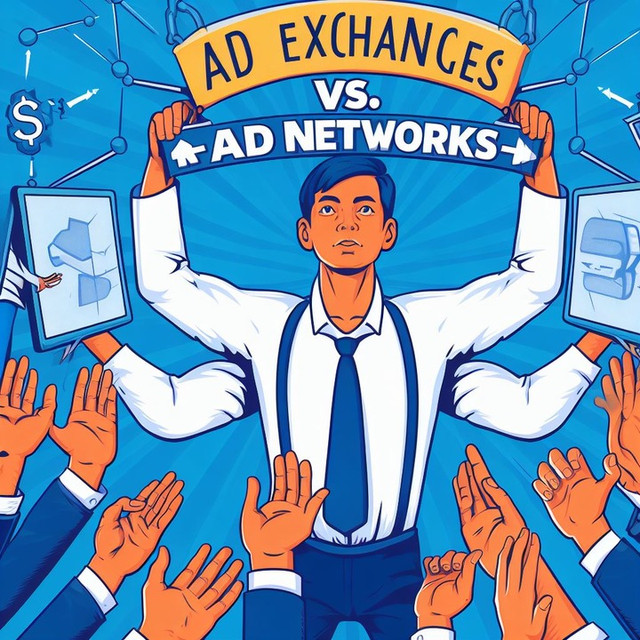Understanding how does an ad exchange work is critical to extract the most value. We will discuss in this article about ad exchanges like Google AdX connect publishers and advertisers through real-time bidding auctions powered by supply and demand dynamics. For publishers, exchanges provide access to greater advertiser demand, driving up ad rates and revenue. Bigfourth leverages its deep working knowledge of exchanges to help clients configure the optimal setup balancing price, demand quality, and inventory controls.
Introduction
The world of digital advertising is rapidly evolving. As more consumers shift to online platforms, advertisers look for effective ways to reach their target audiences. This is where ad exchanges come into play. But how does an ad exchange work?
An ad exchange is a virtual marketplace that connects publishers and advertisers to buy and sell digital ad inventory. It facilitates automated buying and selling of ad impressions through real-time bidding (RTB).
In 2022, global digital ad spending is projected to reach $515 billion, with programmatic transactions making up a significant portion. As programmatic advertising gains prominence, understanding how does an ad exchange work becomes critical.
On one side, publishers leverage supply-side platforms (SSPs) to sell their ad inventory on an exchange. They provide details of their ad spaces like size, type, placement, and target audience.
On the other side, advertisers use demand-side platforms (DSPs) to connect to an exchange and define their campaign requirements. When a user visits a website, the exchange matches the advertiser demand with the available ad impressions via real-time auctions.
How does an ad exchange work to facilitate this automated buying and selling? Here’s a quick rundown:
When a user visits a website, the exchange collects data via cookies.
It identifies potential buyers whose criteria match the user data and triggers a bid request.
Interested buyers respond with bids for the impression.
The exchange selects the winning bid and serves the ad.
This real-time bidding and selling happens in milliseconds, enabling high transaction volumes.
There are three main types of ad exchanges:
Open ad exchanges – Offer an open auction model with a large inventory.
Private ad exchanges – Closed platforms for premium publishers and select advertisers.
Preferred deals – Allow direct deals between publishers and advertisers.
How does an ad exchange work to benefit publishers and advertisers?
For publishers, the key advantages include:
- Access to greater demand and increased competition, driving up the value of inventory.
- More control over ad placements, ad formats, pricing through minimum CPMs.
- Detailed analytics and insights into inventory performance.
For advertisers, the main benefits are:
- Access to a large, global inventory across websites and apps.
- Advanced targeting capabilities for focused reach.
- Full transparency into impression-level costs.
- More control over ad frequency, budget, and blacklisting unwanted inventory.
As ad spend continues to shift online, how does an ad exchange work will only grow in importance. Marketers must leverage exchanges to capitalize on programmatic advertising and achieve results efficiently at scale.
In this guide, we’ll explore how does an ad exchange work in further detail, including their role in the programmatic ecosystem, how to choose the best exchange, and the future outlook for ad exchanges.
What is an ad exchange?

An ad exchange is a digital marketplace that enables the buying and selling of online ad impressions between publishers and advertisers. It is a key component of programmatic advertising.
Acting as a supply-side platform (SSP), a publisher can connect to an ad exchange to offer their ad inventory for sale. The ad exchange then makes this inventory available to advertisers through demand-side platforms (DSPs).
The exchange allows publishers to get the best price for their ad units while giving advertisers access to a large inventory of potential ad placements to achieve their campaign goals.
Real-time bidding (RTB) technology powers transactions on ad exchanges. When an impression becomes available, advertisers can bid for the opportunity to show their ads. The highest bidder wins each impression auction.
Here is an overview of how ad exchanges work:
| Step | Description |
| 1 | Publisher connects to an ad exchange via an SSP |
| 2 | Exchange collects the publisher’s ad inventory details |
| 3 | When a user visits the site, exchange identifies relevant buyers based on data |
| 4 | Buyers bid in real-time auctions for the impression |
| 5 | Highest bidder wins and their ad is served to the user |
A key benefit of ad exchanges is automation. The buying and selling happens programmatically in milliseconds without any human involvement. This allows high volumes of impressions to be traded efficiently.
Ad exchanges offer benefits to both publishers and advertisers:
For publishers – Access to greater demand, increased yield, pricing control, detailed analytics.
For advertisers – Transparent pricing, targeting capabilities, extensive reach, brand safety.
As programmatic advertising expands globally, how does an ad exchange work will continue playing a central role in the digital advertising ecosystem.
How does an ad exchange work?

Now that we’ve covered the basics of what an ad exchange is, let’s look at how does an ad exchange work in more detail.
An ad exchange is fueled by real-time interactions between supply and demand. Publishers supply ad inventory, while advertisers create the demand. The exchange acts as a bridge facilitating automated transactions between the two sides.
How does an ad exchange work to make this buying and selling possible? There are five key steps:
Steps in an ad exchange transaction
| Step | Description |
| 1. Publisher connects | The publisher uses a supply-side platform (SSP) to connect and send its ad inventory to the exchange. |
| 2. Ad call triggered | When a user visits the publisher’s site, the ad server calls the exchange for an ad. |
| 3. Bid request sent | The exchange identifies potential buyers based on data and sends them a real-time bid request. |
| 4. Buyers bid | Interested buyers respond to the bid request with bids based on their campaign objectives and budgets. |
| 5. Ad served | The exchange selects the winning bid and serves the ad to the user’s browser immediately. |
This sequence highlights the automated nature of transactions on an ad exchange. As soon as inventory becomes available, the exchange springs into action to sell it via real-time bidding.
How does an ad exchange work to manage this superfast buying and selling? The exchange relies on advanced technology:
Cookies to collect data on site visitors to identify potential buyers.
Real-time bidding platform to instantly facilitate the bids and auction.
Ad serving technology to deliver the winning ad seamlessly to the user’s browser.
Benefits of real-time bidding
Real-time bidding is the core technology that powers an exchange. Here are some benefits:
- Automated buying and selling of impressions in real-time.
- Publishers get access to many demand sources simultaneously.
- Advertisers can target users contextually at an impression level.
- Transparent auction model ensures optimal pricing.
How does an ad exchange work has evolved considerably over the years but real-time bidding remains at its heart. As technology improves, exchanges now process up to 10 million bid requests per second!
Understanding the mechanics behind an exchange helps publishers maximize the value of their ad inventory and helps advertisers reach their audiences more effectively. Whether you are a publisher or an advertiser, exchanges provide the capabilities to trade programmatically at immense scale.
Types of ad exchanges

There are primarily three different types of ad exchanges:
- Open ad exchanges
- Private ad exchanges
- Preferred deals
Each type of exchange operates on a somewhat different model and offers varying benefits to publishers and advertisers. Let’s look at how each one works.
Open ad exchanges
An open ad exchange provides an open auction environment where any buyer can bid on the available ad inventory. There are no restrictions on advertisers in terms of accessing the exchange.
In an open exchange, the publisher makes its inventory available to all buyers. When an impression becomes available, a bid request is sent out and buyers can place bids to win the impression. The highest bidder wins the right to serve their ad.
Open exchanges offer a transparent auction model and use real-time bidding technology to ensure optimal pricing. For advertisers, the benefit is access to a large, unrestricted pool of ad inventory spanning multiple publishers.
However, open exchanges may have limited vetting of inventory sources. This can pose a risk of low quality or fraudulent inventory.
Some top open ad exchanges are:
Private ad exchanges
Also known as private marketplaces (PMPs), private ad exchanges offer a closed environment accessible only to select buyers. The publisher controls access to its ad inventory by hand-picking the advertisers who can participate.
PMPs operate like closed auction events. Only invited advertisers can bid on impressions. This offers more control to publishers in choosing who accesses their audience.
For advertisers, private exchanges provide higher quality inventory from premium publishers. But advertisers need to establish direct relationships with publishers to gain access.
Some top private ad exchanges are:
Preferred deals
In a preferred or guaranteed deal, the publisher directly negotiates a fixed price for its ad inventory with select advertisers. This private deal is then executed on the ad exchange.
Preferred deals offer exclusive access to the publisher’s audience at a pre-agreed pricing. This benefits both parties with pricing transparency and inventory quality assurance.
The deal terms like pricing, ad formats, volume etc. are negotiated upfront between the buyer and seller. The exchange provides the technology to manage the delivery based on the negotiated terms.
Comparison of exchange types
| Type | Access | Pricing | Benefits |
| Open | Available to all buyers | Real-time bidding | Extensive reach for advertisers |
| Private | Restricted access | Real-time bidding | Premium inventory for advertisers |
| Preferred deals | Exclusive access | Fixed pricing | Pricing transparency for both parties |
The type of exchange impacts inventory access, pricing models and overall benefits. Evaluating their pros and cons can help publishers and advertisers determine the best exchange strategy.
As the programmatic ecosystem matures, we will likely see more convergence across open, private and preferred exchange models. The technology capabilities made possible so how does an ad exchange work will continue shaping the future of digital advertising.
Who uses ad exchanges?

Ad exchanges connect publishers looking to sell ad inventory with advertisers looking to buy digital ad placements. The exchange provides an automated platform for these buyers and sellers to transact.
But ad exchanges also work with other entities in the digital advertising ecosystem. Here are the key players that leverage ad exchanges:
Publishers
Publishers use ad exchanges to sell their website, mobile app or video ad inventory. Exchanges give publishers access to demand from advertisers, ad networks, DSPs, trading desks and more.
Key benefits for publishers:
- Sell ad inventory at optimal pricing via real-time bidding auctions.
- Access high volumes of demand from many sources.
- Control pricing with minimum floors and premium deals.
- Gain transparency into demand and inventory performance.
Top publishers working with major ad exchanges include:
The New York Times
Forbes
CNN
BBC
Advertisers
Advertisers use ad exchanges to access a large volume of ad inventory across many publishers. Exchanges provide targeting capabilities to reach specific users and placements.
Key benefits for advertisers:
- Extensive reach across websites, apps and verticals.
- Automated buying and optimization of campaigns.
- Advanced targeting options like geo, contextual, behavioral etc.
- Full transparency into pricing via auction model.
Top brands leveraging exchanges are:
P&G
Unilever
Toyota
Samsung
Ad networks
Ad networks integrate with ad exchanges to expand supply for their clients. Networks can bid on exchange inventory on behalf of advertisers to run campaigns.
Benefits for ad networks:
- Access to real-time bidable inventory at massive scale.
- Complement owned-and-operated inventory with exchange supply.
- Offer clients access to exchange inventory without developing exchange capabilities.
Leading ad networks plugged into exchanges:
Google AdSense/AdMob
Yahoo Ad Network
OpenX Ad Network
Facebook Audience Network
Demand-side platforms
Demand-side platforms (DSPs) provide the technology interface for advertisers to connect with and buy from ad exchanges. DSPs enable automated media buying across exchanges.
Benefits for DSPs:
- Access to extensive real-time bidable exchange inventory
- Integrations with all major exchanges
- Tools to manage, optimize and report on exchange media buying.
- Aggregate demand from advertisers into a single platform.
Top DSPs integrates with exchanges:
The open nature of ad exchanges allows them to support a diverse ecosystem of buyers, sellers and intermediaries. Together, these players enable modern programmatic advertising.
Benefits of ad exchanges

Ad exchanges offer significant advantages to both the buy-side (advertisers) and sell-side (publishers). Let’s look at the key benefits:
Benefits for advertisers
For advertisers, ad exchanges provide:
Access to extensive inventory – Exchanges aggregate ad space from thousands of publishers, creating a huge marketplace. This allows advertisers to reach audiences at scale.
Precise targeting – Exchanges enable advertisers to define precise targeting parameters to reach their desired audiences across demographics, interests, behaviors, and more.
Transparent pricing – The real-time bidding model provides impression-level pricing transparency. Advertisers know exactly what they pay.
Performance measurement – Detailed reporting on campaign performance – impressions, clicks, conversions etc. helps analyze results.
Control over ads – Advertisers have control over ad frequency capping, avoid re-targeting, blacklisting unwanted sites, and more.
Automation and efficiency – The programmatic exchange model allows advertisers to buy placements efficiently at scale.
Benefits for publishers
For publishers, ad exchanges provide:
Access to more buyers – Exchanges give publishers instant access to advertisers, DSPs, trading desks and ad networks – maximizing demand for their inventory.
Better ad rates – The auction environment drives up the value of inventory, resulting in higher CPMs for publishers.
Revenue growth – By selling to a multitude of buyers simultaneously, publishers can grow ad revenues quickly.
Granular reporting – Publishers get impression-level data on inventory performance, demand, pricing – helping analyze and optimize monetization.
Control over inventory – Publishers can control which buyers, ads, and price floors are associated with their inventory.
Reduce unsold inventory – Exchanges help monetize remnant inventory by connecting with thousands of demand sources.
New ad formats – Exchanges support diverse ad formats – display, native, video, mobile etc. – giving more options for monetization.
Benefits of real-time bidding
At its core, the real-time bidding model is what enables ad exchanges to efficiently and transparently connect supply with demand. Real-time bidding offers the following advantages:
- Instant automated buying and selling of digital ad impressions.
- Dynamic demand-based pricing for each impression via auction model.
- Ability to apply data for precise targeting of each ad impression.
- Transparency for buyers and sellers into granular auction performance.
RTB has transformed programmatic advertising. It powers the value exchange on modern ad exchanges. The benefits will ensure how does an ad exchange work remain central to future of digital advertising.
Ad exchanges vs. ad networks

Ad exchanges and ad networks are both used to sell digital advertising inventory. However, there are some key differences in how they operate and function for buyers and sellers.
How does an ad networks work?
An ad network brings together ad inventory from many publishers into a single platform. The network then packages the inventory for sale to advertisers based on targeting criteria like demographics, interests, location etc.
The advertiser buys ad placements from the network, without necessarily knowing the exact publisher site. The network acts as an intermediary connecting advertiser demand with publisher supply.
A major portion of inventory on ad networks is sold through non-RTB methods like direct sales, bulk discounts, sponsorships etc. Real-time bidding inventory may be limited on ad networks.
Top ad networks include Google AdSense, Media.net, Facebook Audience Network, Taboola etc.
How does an ad exchange work?
In an ad exchange, the publisher makes its inventory directly available to advertisers and intermediaries like DSPs. The exchange matches impression-level supply with demand via real-time bidding.
Every impression sale is transparent, with the buyer knowing the publisher and price paid. The exchange acts as a neutral platform facilitating the transactions between buyers and sellers.
Real-time bidding inventory constitutes a majority of transactions on exchanges. Exchanges do not directly sell or mark up inventory like networks. Leading ad exchanges are Google AdX, AppNexus, Rubicon Project, OpenX etc.
Key differences
| Ad Networks | Ad Exchanges |
| Sell aggregated inventory from publishers | Publishers sell own inventory directly |
| Opaque sourcing of inventory | Transparent impression-level sourcing |
| Limited real-time bidding inventory | Primarily real-time bidding transactions |
| Sell campaigns through direct and programmatic channels | Exchange acts as neutral facilitator of transactions |
| Act as intermediaries between advertisers and publishers | Direct connections between buyers and sellers |
While networks and exchanges both enable digital ad transactions, exchanges offer greater transparency, targeting capabilities, and automation benefits to both publishers and advertisers.
As programmatic advertising grows, ad exchanges are playing an increasingly prominent role for premium publishers and advertisers demanding advanced capabilities. Ad exchanges will continue to differentiate from traditional networks by providing superior automation, visibility and control.
Ad exchanges vs. supply side platforms
Ad exchanges and supply side platforms (SSPs) are both integral technologies on the sell-side of programmatic advertising. But they serve different functions for publishers.
What is a supply side platform?
A supply side platform is software used by publishers to automate selling their advertising inventory programmatically.
Key capabilities offered by SSPs:
- Connecting with multiple ad exchanges and demand sources
- Managing publisher’s ad inventory
- Setting floor prices, controlling deal terms
- Automated optimization to maximize revenue
- Detailed reporting on performance
Top SSPs in the market are Google Ad Manager, PubMatic, OpenX, Rubicon Project, and more.
How SSPs and exchanges differ
While SSPs and exchanges facilitate programmatic ad sales for publishers, they are distinct in their capabilities:
| Supply Side Platforms | Ad Exchanges |
| Inventory management system used by publishers | Neutral marketplace connecting buyers and sellers |
| Focus only on sell-side | Cater to both buy-side and sell-side |
| Don’t buy/resell media | May run private auctions or make special deals |
| Publisher-facing dashboard and controls | No direct publisher tools or interface |
| Integrates with multiple exchanges | Independent exchange interacts with many SSPs |
Publishers use SSPs specifically to optimize and automate selling their ad inventory across multiple channels including exchanges, networks, DSPs etc.
How does an ad exchange work provide an open marketplace for buyers and sellers to transact through real-time bidding. Exchanges are a destination for inventory while SSPs help publishers manage their media selling.
How SSPs and exchanges work together
While SSPs and exchanges play different roles, they work closely together:
- SSPs integrate with multiple exchanges to expand reach for their publisher clients.
- Exchanges provide the real-time bidding capabilities for SSPs to facilitate automated selling.
- Publishers use SSPs to control which exchanges get access to their inventory.
- Exchanges rely on SSPs to bring sell-side ad inventory into the marketplace.
As programmatic advertising expands, the interplay between SSPs and exchanges will become even more critical to unlock greater value for publishers.
Choosing the best ad exchange

With so many ad exchanges to choose from, how do you pick the right one? Here are some tips for how does an ad exchange work:
Assess your needs
Be clear about what you want to achieve through the ad exchange. Key considerations:
What is your ad monetization goal – brand-building or performance marketing?
What ad formats do you want to monetize – display, video, native, mobile?
What level of control do you need over inventory, data, pricing?
What are your scale requirements in terms of traffic and geography?
Defining your objectives and parameters will help determine the capabilities needed from an exchange.
Evaluate exchange models
Look for an exchange model aligned to your needs:
Open exchanges offer wide reach but less control.
Private exchanges give more control over inventory access and pricing.
Preferred deals enable direct relationships with select buyers.
Assess which model best supports your programmatic strategy. You can also work with multiple exchange types.
Analyze demand partners
Study the demand partners integrated with the exchange. Are the right advertisers and DSPs connected to the exchange? This will impact the buying demand for your ad inventory.
Prefer exchanges with strong relationships with premium buyers in your vertical. Avoid exchanges with bidders focused only on remnant inventory.
Check transparency
Real-time bidding auctions must be transparent. Review if the exchange provides impression-level data like winning bids and clearing prices. This allows monitoring auction performance and optimizing floor pricing strategies.
Also examine if the exchange undergoes regular audits for financial transparency. This ensures accuracy in publisher payouts.
Assess technology capabilities
Evaluate the ad serving performance, capability to support diverse formats and platforms, and how frequently tech is upgraded. These factors impact reliability and scalability.
Exchanges must offer robust anti-fraud capabilities including blacklisting, verification, filtration to ensure ad quality and prevent security issues.
Compare partner support
Look for exchanges investing in publisher success through dedicated account management, technical support, advisory services, training etc.
Ongoing optimization support helps fully capitalize on the value exchanges offer. Relying just on self-serve platforms can limit long-term growth.
Shortlist options
Research multiple exchanges, go through reviews, speak to current customers. Shortlist platforms matching your needs and exchange philosophy.
Try exchanges and measure
Test shortlisted exchanges with a portion of traffic to gauge performance vs. your existing setup. Measure impact on key metrics like fill rates, CPM, RPM and make data-driven exchange decisions.
Evaluating exchanges thoroughly and picking the optimal partners is vital for programmatic success. As strategic partners, exchanges can elevate the value of publisher inventory and advertiser campaigns.
Top ad exchanges for publishers
Choosing the right ad exchange is critical for publishers to maximize the value of their website or mobile app inventory. Here are some of the top ad exchanges for publishers:
Google Ad Manager
Part of the Google Marketing Platform, Google Ad Manager (formerly DoubleClick) is one of the most widely used publisher ad servers.
It offers a full-stack ad serving, management and monetization solution for publishers. Ad Manager provides seamless access to real-time bidding inventory from Google Ad Exchange, one of the largest exchanges globally.
Benefits:
- Massive demand from Google’s advertiser base
- Advanced targeting and robust reporting
- Premium buying via Google AdX and partnerships
- Integrated with Google AdSense for non-programmatic demand
Ad Manager works well for publishers looking to capitalize on Google’s scale while retaining control over decisioning.
OpenX
OpenX Ad Exchange is one of the pioneers in the ad exchange landscape. The self-serve platform provides access to leading demand partners through API integrations.
Benefits:
- Strong demand from top DSPs and networks
- Integrated header bidding solution Ad Server for transparency
- Yield analysts support for publishers
- Focus on mid-market and SMB publishers
OpenX is ideal for small-to-medium publishers looking for managed services bundled with exchange access.
Magnite CTV
Specializing in connected TV (CTV) ad inventory, Magnite provides monetization for many leading streaming publishers.
Benefits:
- Unified auction marketplace for CTV inventory
- Access to Magnite’s CTV-focused buyer base
- Transparent pricing with real-time reporting
- Inventory controls to manage frequency, invalid traffic, etc.
Magnite is the leader for publishers focused exclusively on optimizing streaming/OTT video monetization.
Key criteria for evaluation
| Parameter | Details |
| Demand quality | Buyer reputation, premium brands, campaign quality |
| Technology | Ad serving, antifraud, billing and payments |
| Support | Onboarding, optimization, account management |
| Transparency | Bid-level visibility, transaction security |
| Inventory controls | Price floors, targeting, blocklists etc. |
| Fees | Rev share %, minimums, hidden fees |
Evaluating exchanges on these parameters will help publishers select the right partners aligned to their programmatic goals. As the ad tech ecosystem matures, publishers now have more exchange options to maximize the value of their ad inventory.
Conclusion
In the fast-evolving digital advertising landscape, ad exchanges play a crucial role in connecting publishers and advertisers. As programmatic advertising expands globally, understanding how does an ad exchange work is more important than ever.
Some key summary points:
- Ad exchanges are digital marketplaces enabling automated buying and selling of ad impressions between advertisers and publishers.
- They rely on real-time bidding technology to run instant auctions for each impression, valuing inventory dynamically.
- For publishers, exchanges provide access to greater demand, higher ad rates, more controls over inventory, detailed analytics and the ability to monetize unsold inventory.
- For advertisers, exchanges offer transparency over impressions bought, advanced targeting capabilities, brand safety features, and the means to buy digital media efficiently at scale.
- The major types of exchanges are open exchanges, private exchanges, and preferred deals, each offering different benefits to buyers and sellers.
- Ad exchanges differ from traditional ad networks in offering much greater transparency, targeting precision, and focus on real-time bidding transactions.
As ad dollars continue shifting to automated buying platforms, how does an ad exchange work will be the primary channel enabling programmatic transactions. Both publishers and advertisers must actively evaluate various ad exchange options to identify the best partners matching their goals.
With the right exchange strategies, publishers can maximize the yield of their ad inventory while advertisers can optimize investments to engage high-value audiences. The exchange landscape will only grow more diverse, competitive and technology-driven going forward.
Staying up-to-date on the latest exchange offerings and proactively assessing their fit will be vital to succeed in the world of programmatic advertising.
Website Services and Our Mission
As programmatic advertising grows globally, publishers must leverage the best ad exchanges and networks to maximize revenue. This is where Bigfourth’s expertise helps publishers succeed. With over 15 years of experience in digital monetization, Bigfourth partners with publishers to optimize their Google Ad Manager, AdSense, and overall exchange strategy.
Beyond how does an ad exchange work, Bigfourth LTD also specializes in managing Google AdSense for publishers. With advanced implementations of Auto ads, In-Article ads, and Dynamic creatives, Bigfourth unlocks incremental AdSense earnings for clients. Our hands-on optimization strategy evaluates placements, ad types, viewability, and user engagement to maximize RPMs.
As a Google Marketing Platform Premium partner, Bigfourth provides exclusive Google resources to clients including pre-bid filtering, forecasting, bulk editing capabilities, and Google reps support. This elevates the monetization potential for publishers significantly.
Bigfourth’s strategic consulting helps clients navigate the evolving ad tech landscape. Our experts stay on top of exchange innovations, Google policy changes, and privacy regulations to identify new opportunities to grow ad revenue. Ongoing A/B testing continually improves performance.
With expertise across website, mobile app, and CTV ad monetization, Bigfourth is the ideal programmatic advertising partner for digital publishers seeking to maximize their potential. Visit Our website to learn more and request a custom proposal.
Contact Bigfourth LTD
Website: https://bigfourth.com/
Email: [email protected]
Fanpage: https://www.facebook.com/bigfourth/
Linkedin: https://www.linkedin.com/in/bigfourth/
